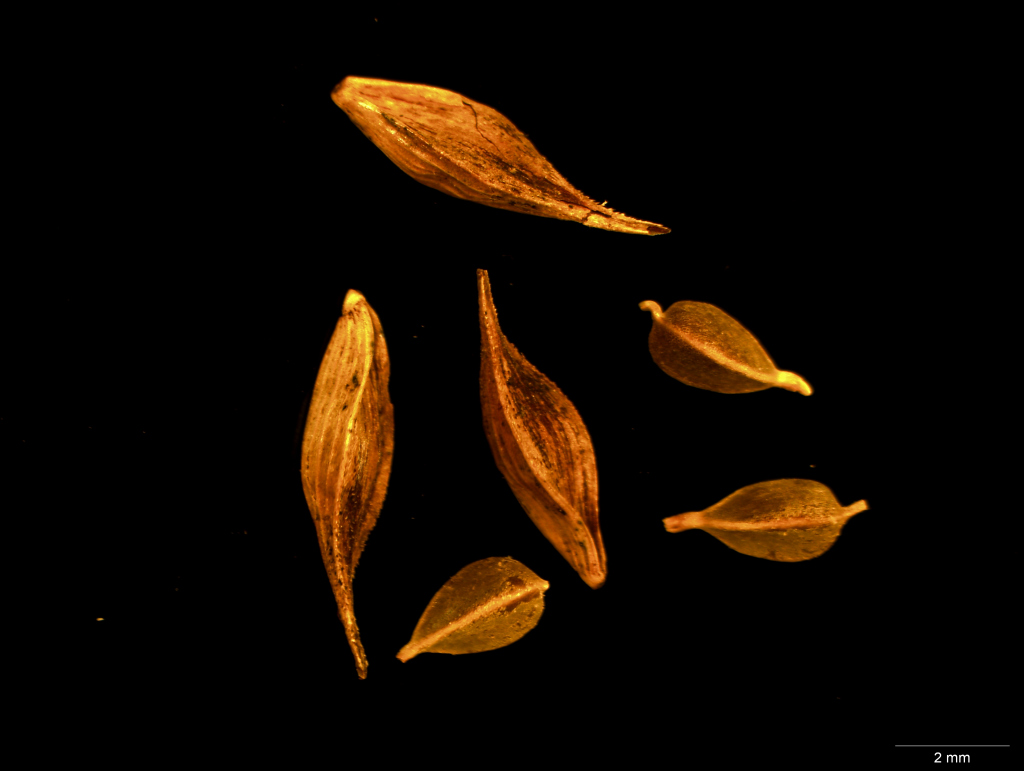Carex longebrachiata
Boeck. Bergalia TussockRhizome short; shoots densely tufted. Culms erect, terete to trigonous, smooth below, scabrous above, 40–80 cm long, c. 1.3 mm diam. Leaves exceeding culms, 2–4 mm wide; sheath yellow-brown; ligule retuse. Inflorescence drooping, 40–90 cm long, usually longer than culm, with 1–8 spikes per node; lowest involucral bract shorter than inflorescence. Spikes long-pedunculate, drooping at maturity, distant, 2.5–5.5 cm long; uppermost spike usually with female flowers above a long male portion, occasionally with male flowers also above, rarely entirely male; lower spikes with female flowers above a short male portion, or entirely female; glumes acute to obtuse, shortly mucronate, yellow-brown to red-brown; female glumes 3.5–5.5 mm long; utricles 4.5–7 mm long, 1.5–1.8 mm diam., narrow-obovoid, prominently several-nerved abaxially (faint adaxially), hispid above, pale brown; beak 1.5–2.5 mm long, with apex bifid or split; style 3-fid. Nut obovoid, trigonous, yellow-brown. Flowers spring–summer.
GleP, VVP, GipP, WaP, CVU, DunT, EGL, EGU, HSF, HNF, Strz, MonT, HFE, VAlp. Also NSW. Naturalized in New Zealand. Recorded as a casual wool alien in United Kingdom. Occurs chiefly on low-lying flats and near watercourses at low altitudes in the east (largely replaced at higher elevations by C. iynx), with disjunct westerly occurrences in the Eltham area and near Portland (note that some distribution records may be based on misdetermined material of C. iynx).
Very close to C. iynx, differing especially in the terminal spike usually having female flowers above male flowers, in the generally more slender spikes (3–5 mm diam. at maturity versus 5–8 mm diam. in C. iynx), and the usually narrower and shorter glumes (both in absolute terms and relative to utricle length: extending no higher than the base of the beak of the utricle). The leaf-sheaths are generally paler yellow-brown and have less fibrous material remaining around them than in C. iynx. Leaves are often rather stiffer and broadly M-shaped in cross-section in C. longebrachiata (cf. V-shaped in C. iynx). Although most specimens may be readily assigned to one of the two species, some specimens appear to combine characters of both. It is possible that both species would be more realistically contained within a broader concept of C. longebrachiata (the first-described of the two).
It is naturalised in New Zealand, where it is a major pasture weed in some areas, where it can sometimes form large infestations across a broad ecological amplitude. It also readily invades native vegetation in New Zealand. The species is banned in New Zealand.
Wilson, K.L. (1994). Cyperaceae. In: Walsh, N.G.; Entwisle, T.J., Flora of Victoria Vol. 2, Ferns and Allied Plants, Conifers and Monocotyledons, pp. 238–356. Inkata Press, Melbourne.
 Spinning
Spinning

